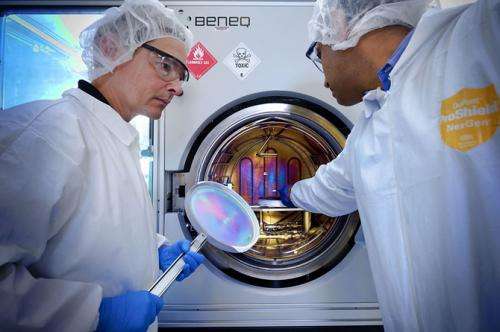Space-age materials, one atomic layer at a time

Space can be a dangerous place. Micrometeorites, solar particles, and space junk — everything from spent rocket stages to paint fragments — zip past satellites at up to 12.4 miles (20 kilometers) per second, posing hazards to their sensitive spacecraft optics, detectors, and solar panels.
Although engineers have developed different techniques to safeguard spacecraft from these fast-moving whirling dervishes, nothing provides 100-percent protection.
A technologist at NASA's Goddard Space Flight Center in Greenbelt, Md., however, is experimenting with an emerging technology that might provide another, perhaps more effective, technique for defending sensitive spacecraft components from the high-velocity bombardments.
Vivek Dwivedi and his collaborator, chemical engineering professor Raymond Adomaitis from the University of Maryland, College Park, are using atomic layer deposition (ALD) — a rapidly evolving technology for coating plastics, semiconductors, glass, Teflon, and a plethora of other materials — to create a new super-strong, ultra-thin coating made of tiny tubes of boron nitride, similar in appearance to the bristles on a toothbrush.
''Crystalline boron nitride is one of the hardest materials in the world,'' Dwivedi said, making it ideal as a coating to make sensitive spacecraft component less susceptible to damage when struck by space dust, tiny rocks, and high-energy solar particles.
Atomic Layer Deposition
The ALD technique, which the semiconductor industry has adopted in its manufacturing of computer chips, involves placing a substrate material inside a reactor chamber and sequentially pulsing different types of precursor gases to create an ultrathin film whose layers are literally no thicker than a single atom.
ALD differs from other techniques for applying thin films because the process is split into two half reactions, is run in sequence, and is repeated for each layer. As a result, technicians can accurately control the thickness and composition of the deposited films, even deep inside pores and cavities. This gives ALD a unique ability to coat in and around 3-D objects. This advantage — coupled with the fact that technologists can create films at much lower temperatures than with the other techniques — has led many in the optics, electronics, energy, textile, and biomedical-device fields to replace older deposition techniques with ALD.
According to Dwivedi, if technicians use ALD to coat glass with aluminum oxide, for example, they can strengthen glass by more than 80 percent. The resulting thin films act like ''nano putty,'' filling the nanometer-scale defects found in glass — the very same tiny cracks that cause glass to break when struck by an object. ''This ALD application has profound possibilities for the next-generation crew modules,'' Dwivedi said. ''We could decrease the thickness of the glass windows without sacrificing strength.''
''It's really exciting,'' said Ted Swanson, Goddard's assistant chief for technology for mechanical systems. ''This is an emerging technology that offers a wholly new way to protect spacecraft components, perhaps more effectively than what is possible with current techniques. Just as important, with ALD, we can lay down material less expensively.''
''Hardest Materials in the 'World'
This isn't to say the task is easy, Dwivedi said.
Manufacturing an ALD-based coating made of boron and other precursor gases is exceptionally difficult to do. Currently, technologists manufacture boron films by reacting boron powder with nitrogen and a small amount of ammonia in a chamber that must be heated to a scorching 2,552 degrees Fahrenheit — an expensive process. With ALD, ultrathin boron-nitride film could be laid in a chamber no hotter than 752 degrees Fahrenheit.
''Our team has studied the difficulties and think we understand why they're happening,'' Dwivedi said. As a result, he believes the team will succeed at depositing boron nitride on a silicon substrate by next year. If subsequent tests at Goddard and NASA's Langley Research Center in Hampton, Va., prove the material's effectiveness as a protective coating, he believes instrument designers could one day use the technology to coat mirrors, spacecraft buses, and other components. Such test could occur as early as next summer.
In addition to creating a protective coating, Dwivedi and his team are using funding from Goddard's Internal Research and Development program and NASA's Center Innovation Fund to test the technique as a possible way to coat X-ray telescope mirrors, which must be curved to collect high-energy X-ray photons that would otherwise pierce flat mirrors, and radiators needed to direct heat away from sensitive instruments.
''This technology can coat anything. It is perfect point-to-point. There are so many applications for this technology,'' Dwivedi said. ''The only thing limiting its use is your imagination.''
Provided by NASA


















